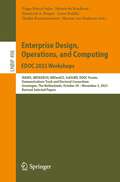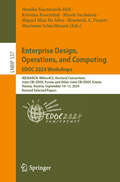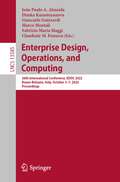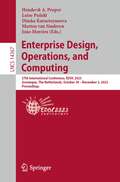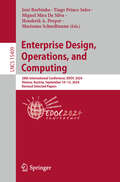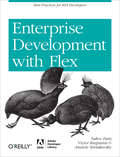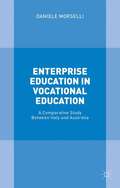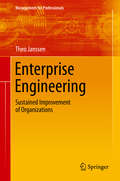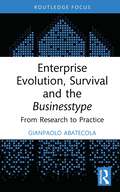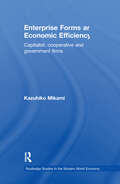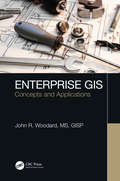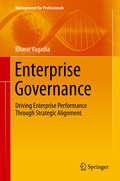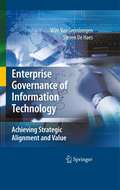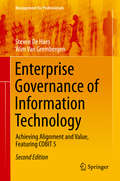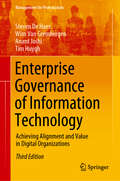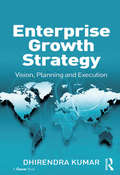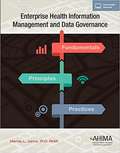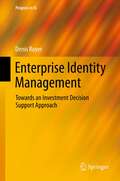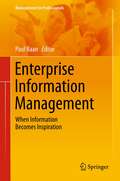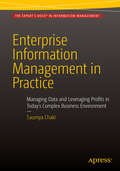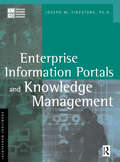- Table View
- List View
Enterprise Denied: Origins of the Decline of American Railroads, 1897-1917
by Albro MartinA 1971 piece that explores the struggle of the American Railroads in the early twentieth century.
Enterprise Design, Operations, and Computing. EDOC 2022 Workshops: IDAMS, SoEA4EE, TEAR, EDOC Forum, Demonstrations Track and Doctoral Consortium, Bozen-Bolzano, Italy, October 4–7, 2022, Revised Selected Papers (Lecture Notes in Business Information Processing #466)
by Giancarlo Guizzardi Marco Montali Henderik A. Proper Fabrizio Maria Maggi Claudenir M. Fonseca Tiago Prince SalesThis book constitutes revised selected papers from the international workshops, the EDOC Forum and the Demonstration and Doctoral Consortium track, that were held at the 26th International Conference on Enterprise Design, Operations, and Computing, EDOC 2022. The conference took place in Bozen-Bolzano, Italy, during October 3–7, 2022.The conference focuses on the area of enterprise computing, this year with the special emphasis on the theme of designing and operating “Flexible Enterprises”. Workshops within EDOC cover more focused topics and allow for the presentation and discussion of work that is in the earlier development stages. The 18 full and 8 short papers included in this volume were carefully reviewed and selected from 82 submissions. They stem from the following satellite events: – Workshop on Intelligent Digital Architecture, Methods, and Services for Industry 4.0 and Society 5.0 (IDAMS) – 14th Workshop on Service-oriented Enterprise Architecture for Enterprise Engineering (SoEA4EE) – 17th Workshop on Trends in Enterprise Architecture Research (TEAR) – EDOC Forum – Demonstrations Track – Doctoral Consortium
Enterprise Design, Operations, and Computing. EDOC 2023 Workshops: IDAMS, iRESEARCH, MIDas4CS, SoEA4EE, EDOC Forum, Demonstrations Track and Doctoral Consortium, Groningen, The Netherlands, October 30–November 3, 2023, Revised Selected Papers (Lecture Notes in Business Information Processing #498)
by Marten Van Sinderen Henderik A. Proper Sybren De Kinderen Dimka Karastoyanova Tiago Prince Sales Luise PufahlThis volume constitutes revised selected papers of several workshops, the EDOC Forum and the Demonstrations and Doctoral Consortium track, which were held in conjunction with the 27th International Conference on Enterprise Design, Operations, and Computing, EDOC 2023, in Groningen, The Netherlands, during October 30–November 3, 2023. The 18 revised full papers and 7 short papers presented in this book were carefully reviewed and selected from 37 submissions. They stem from the following satellite events: - Workshop on Intelligent Digital Architecture, Methods, and Services for Industry 4.0 and Society 5.0 (IDAMS)- Workshop on Empirical Methodologies for Research in Enterprise Architecture and Service-Oriented Computing (iRESEARCH)- Workshop on the Modelling and Implementation of Digital Twins for Complex Systems (MIDas4CS)- Workshop on Service-oriented Enterprise Architecture for Enterprise Engineering (SoEA4EE)- EDOC Forum- Demonstrations Track- Doctoral Consortium
Enterprise Design, Operations, and Computing. EDOC 2024 Workshops: iRESEARCH, MIDas4CS, Doctoral Consortium, Joint CBI–EDOC Forum and Other Joint CBI-EDOC Events, Vienna, Austria, September 10–13, 2024, Revised Selected Papers (Lecture Notes in Business Information Processing #537)
by Henderik A. Proper Monika Kaczmarek-Heß Marianne Schnellmann Kristina Rosenthal Marek Suchánek Miguel Mira Da SilvaThis volume constitutes revised selected papers of two workshops, the Doctoral Consortium, the Joint CBI-EDOC Forum and and other Joint CBI-EDOC event, which were held in conjunction with the 28th International Conference on Enterprise Design, Operations, and Computing, EDOC 2024, in Vienna, Austria, in September 10–13, 2024. The presented revised full papers in this book were carefully reviewed and selected. They stem from the following satellite events: iRESEARCH – 2nd International Workshop on Empirical Methodologies for Research in Enterprise Architecture and Service-oriented Computing MIDas4CS – 2nd Workshop on the Modelling and Implementation of Digital Twins for Complex Systems Joint CBI–EDOC Forum Joint CBI–EDOC Case Reports Track Joint CBI–EDOC Tools & Demos Track EDOC Doctoral Consortium CBI Mini Dagstuhl Seminars
Enterprise Design, Operations, and Computing: 26th International Conference, EDOC 2022, Bozen-Bolzano, Italy, October 3–7, 2022, Proceedings (Lecture Notes in Computer Science #13585)
by Giancarlo Guizzardi Marco Montali João Paulo A. Almeida Dimka Karastoyanova Fabrizio Maria Maggi Claudenir M. FonsecaThis book constitutes the proceedings of the 26th International Conference on Enterprise Design, Operations, and Computing, EDOC 2022, which took place in Bozen-Bolzano, Italy, in October 2022. The 15 full papers included in this book were carefully reviewed and selected from 48 submissions. They were organized in topical sections as follows: enterprise security; enterprise architecture; business process modeling and monitoring; business process mining and discovery; and process-driven applications.
Enterprise Design, Operations, and Computing: 27th International Conference, EDOC 2023, Groningen, The Netherlands, October 30 – November 3, 2023, Proceedings (Lecture Notes in Computer Science #14367)
by Marten Van Sinderen João Moreira Henderik A. Proper Dimka Karastoyanova Luise PufahlThis book constitutes the refereed proceedings of the 27th International Conference on Enterprise Design, Operations, and Computing, EDOC 2023, held in Groningen, The Netherlands, during October 30–November 3, 2023.The 12 full papers included in this book were carefully reviewed and selected from 36submissions. They were organized in topical sections as follows: Enterprise Modeling, Enterprise Architecture & Engineering, Model-Based Software Engineering, Enterprise Analysis with Process Mining, Process Improvement & Engineering, and Modeling in an Enterprise Context.
Enterprise Design, Operations, and Computing: 28th International Conference, EDOC 2024, Vienna, Austria, September 10–13, 2024, Revised Selected Papers (Lecture Notes in Computer Science #15409)
by Henderik A. Proper José Borbinha Tiago Prince Sales Marianne Schnellmann Miguel Mira Da SilvaThis book constitutes the refereed proceedings of the 28th International Conference on Enterprise Design, Operations, and Computing, EDOC 2024, held in Vienna, Austria, during September 10–13, 2024. The 18 full papers included in this book were carefully reviewed and selected from 70 submissions. They were organized in topical sections as follows: AI, ML and Agents; BPM and WFM; Business Models, Platforms and Strategic Management; Enterprise and IT Architecture; IT and Software Architecture; Modeling Methods, Data and Component; Process Mining and Monitoring; and Sustainability and Resilience.
Enterprise Development with Flex: Best Practices for RIA Developers (Adobe Developer Library)
by Yakov Fain Victor Rasputnis Anatole TartakovskyIf you want to use Adobe Flex to build production-quality Rich Internet Applications for the enterprise, this groundbreaking book shows you exactly what's required. You'll learn efficient techniques and best practices, and compare several frameworks and tools available for RIA development -- well beyond anything you'll find in Flex tutorials and product documentation. Through many practical examples, the authors impart their considerable experience to help you overcome challenges during your project's life cycle. Enterprise Development with Flex also suggests proper tools and methodologies, guidelines for determining the skill sets required for the project, and much more. Choose among several frameworks to build Flex applications, including Cairngorm, PureMVC, Mate, and Clear Toolkit Apply selected design patterns with Flex Learn how to extend the Flex framework and build your own component library Develop a sample AIR application that automatically synchronizes local and remote databases to support your sales force Get solutions for leveraging AMF protocol and synchronizing Flex client data modifications with BlazeDS-based servers Determine the actual performance of your application and improve its efficiency
Enterprise Education in Vocational Education: A Comparative Study Between Italy And Australia
by Daniele MorselliThis book develops and illustrates a new promising workshop methodology utilized for the first time in a comparative study between Italy and Australia. It is shown how Change Laboratory workshops are useful to trigger sense of initiative and entrepreneurship in vocational students.
Enterprise Engineering
by Theo JanssenThis book provides a fundamental and practical introduction to Enterprise Engineering, demonstrating how to employ this approach to map the essence of an organization at the core level of internal cooperation. It then explains how, based on these insights, organizations can benefit from opportunities for improvement that would have otherwise gone unnoticed. Further, the book explains how to adapt the structure of an organization to the needs of its management and offers valuable tools for improving and perfecting it, along with guidelines on implementing profound and sustainable organizational changes. The examples and cases it presents show an increase in efficiency of up to 70% and increases in productivity and sales performance of more than 40%, once the flaws in an organization's structure have been identified and resolved.
Enterprise Evolution, Survival and the Businesstype: From Research to Practice (Routledge Focus on Business and Management)
by Gianpaolo AbatecolaThe strategic journey taken by firms starts with entrepreneurial inception and can go all the way through adaptation to sustainable enterprise, exit, or failure. This book charts how new ventures grow through co-evolution and adaptation to get past the initial problems of being new, connecting theories of strategic management and entrepreneurship.Conceptually, the author paints an integrated picture of the challenges arising from the enterprise life cycle. Based on research, the book is also accessible to practitioners and students, in that it provides practice-oriented takeaways about how enterprises can evolve and thrive in turbulent times.Together with executives, entrepreneurs, and policymakers, the book is intended for scholars and postgraduate students, interested in understanding strategic management and entrepreneurship from an evolutionary perspective.
Enterprise Forms and Economic Efficiency: Capitalist, Cooperative and Government Firms (Routledge Studies in the Modern World Economy)
by Kazuhiko MikamiThe book conducts a comparative study on the form of enterprise, focusing on broadly defined cooperative firms in comparison with conventional capitalist firms. It explores the essential advantages and disadvantages of the different types of firms and attempts to answer why capitalist firms are so prevalent in our economy. The book attempts to explain these questions from the viewpoint of "market failure" in the framework of standard microeconomic theory. In this analytical framework, it proposes an alternative system of business organization based upon consumer cooperatives and the market for their memberships, which can coexist consistently with the system of capitalist firms and the stock market within a single market economy. The existing studies of the cooperative sector have been rather ideological. The analytical framework that is presented in this book helps promote scientific exploration of cooperative and other types of firms, which are indispensable and potentially promising constituents of our society.
Enterprise GIS: Concepts and Applications
by John R. WoodardThis book defines and discusses how the field of Enterprise Architecture (EA) can be incorporated into the design of Enterprise Geographic Information Systems (EGIS). The objective of EA is to develop a strategic plan that structures an organization’s resources (data, information, people, and assets) into one team that works together to achieve the company’s objectives in an efficient, agile, and adaptable way. It demonstrates how EA concepts can be incorporated within EGIS by improving the system’s efficiency and reliability. Through real-world examples and step-by-step explanations, the reader will reach a comfortable understanding of the theories and methods discussed in the book.
Enterprise Governance
by Bharat VagadiaThis book is written for business leaders and those that govern organisations. All high performing organisations excel in achieving 7 organisational outcomes: Accountability, Awareness, Adaptability, Agility, Alignment, Action and Achievement. The enterprise governance framework must deliver on these 7 As through penetrating and integrating three organisational governance layers to drive high performance. These include: corporate governance, strategic governance and operational governance. The book unifies traditional corporate governance, leadership, and strategic management processes, whilst seeking to understand what actually happens on the ground to keep the organisation working and delivering ongoing value to its stakeholders. It synthesises these separate streams into a unified enterprise governance framework, posing some challenging questions whilst providing clear insight into how you implement enterprise governance: something that helps deliver on the 7 As and ultimately high performance.
Enterprise Governance of Information Technology
by Wim Van Grembergen Steven De HaesEnterprise governance of information technology is a relatively new concept that is gaining traction in both the academic and practitioner worlds. Going well beyond the implementation of a superior IT infrastructure, "Enterprise Governance of Information Technology" is about defining and embedding processes and structures throughout the organizations that enable both business and IT people to execute their responsibilities, while maximizing the value created from their IT-enabled investments. At the forefront of the field, the authors draw from years of research and advising corporate clients to present the first comprehensive resource on the topic. Featuring numerous case examples from companies around the world, the book integrates theoretical advances and empirical data with practical application, including in-depth discussion of such frameworks as COBIT and VALIT, which are used to measure and audit the value of IT investments and ensuring regulatory compliance. A variety of elements, including executive summaries and sidebars, extensive references, and questions and activities (with additional materials available on-line) ensure that the book will be an essential resource for professionals, researchers, and students alike.
Enterprise Governance of Information Technology
by Steven Haes Wim GrembergenFeaturing numerous case examples from companies around the world, this second edition integrates theoretical advances and empirical data with practical applications, including in-depth discussion on the COBIT 5 framework which can be used to build, measure and audit enterprise governance of IT approaches. At the forefront of the field, the authors of this volume draw from years of research and advising corporate clients to present a comprehensive resource on enterprise governance of IT (EGIT). Information technology (IT) has become a crucial enabler in the support, sustainability and growth of enterprises. Given this pervasive role of IT, a specific focus on EGIT has arisen over the last two decades, as an integral part of corporate governance. Going well beyond the implementation of a superior IT infrastructure, enterprise governance of IT is about defining and embedding processes and structures throughout the organization that enable boards and business and IT people to execute their responsibilities in support of business/IT alignment and value creation from their IT-enabled investments. Featuring a variety of elements, including executive summaries and sidebars, extensive references and questions and activities (with additional materials available on-line), this book will be an essential resource for professionals, researchers and students alike
Enterprise Governance of Information Technology: Achieving Alignment and Value in Digital Organizations (Management for Professionals)
by Anant Joshi Tim Huygh Steven De Haes Wim Van GrembergenThis book integrates theoretical advances and empirical data on Enterprise Governance in Information Technology (EGIT) with practical applications based on numerous case examples. The third revised edition of Enterprise Governance of Information Technology provides professionals and students with the most recent research advancements as well as an in-depth discussion of the recently-introduced Control Objectives for Information and Related Technologies (COBIT) 2019 framework which can be used to facilitate a tailored implementation of effective EGIT. Furthermore, the book features a new chapter which provides readers with hands-on examples from practice and clear insights on how these relate to theory. At the forefront of the field, the authors of this volume draw from years of research and advising corporate clients to present a comprehensive resource on EGIT. Featuring a variety of elements, including executive summaries and sidebars, extensive references, questions and activities and additional online materials, this book is a valuable updated resource for professionals, students and researchers alike.
Enterprise Growth Strategy: Vision, Planning and Execution
by Dhirendra KumarEven during economic downturns businesses have to grow to survive and compete in domestic and international markets. There is always a need to plan for future growth. Enterprise Growth Strategy presents the total process of a growth strategy. Dr Kumar is an engineer who entered the academic world following a long career in manufacturing business and has since taught almost every aspect of business and management. The 'growth strategy' concept he has developed is comprehensive and manifestly practical. Dr Kumar describes mechanisms by which businesses can gain market share; develop, modify, or upgrade products; acquire new or expand existing businesses; transform resources to increase revenue and profitability; reduce cycle time; and empower business associates. Quality concepts - market growth, financial and core competency - are outlined and a variety of growth strategy tools presented. The relationship between continuous improvement metrics and business growth metrics is explained and their relevance to financial performance examined. Examples and case studies are presented to illustrate how different business areas such as Sales and Marketing; Product Development; Operations; Support Services; and the Finance function, contribute. Leadership responsibilities, employee participation in the execution of growth strategy, culture and change issues are also discussed. Business leaders, managers and consultants, academics and teachers, as well as higher level students on business-related courses will find enormous value in this book. It is unusual, if not unique, in presenting the total process from vision to mission, to development of a growth strategy, implementation of initiatives, use of tools, and measurement of both operational and financial outcomes.
Enterprise Growth: The Challenge to Management
by Richard LueckeIn exchange for growing revenues, greater market share, and increasing profitability, the entrepreneurial business must contend both with the challenge of sustaining growth and adopting new modes of management needed for a larger, more complex organization. This chapter addresses these challenges, with an emphasis on how the entrepreneur's own role must change as the business expands.
Enterprise Health Information Management and Data Governance
by Merida L. JohnsThis book provides the fundamentals, principles, and practices for managing the data asset. Data growth rates are increasing at a phenomenal pace for most businesses. The book tackles how healthcare organizations can manage their data in this era of dramatic data explosion and growing deployment of information technologies. Healthcare organizations must understand that their sustainability and future viability relies on the quality of their data and how they manage this resource on an enterprise-wide basis. This text provides a framework and logical structure to help students understand the components of health information management in a digital era and to provide them with opportunities to develop the necessary skills for performing functions associated with these components. Provides an outline of enterprise-wide information management (EIM) for healthcare. Each chapter incorporates a case study, providing a real-world perspective to student learning and exploring the concepts and interrelationships of EIM and data governance. Students are invited to be a part of the case study through a set of activities at the end of each chapter. Advanced concepts are provided at the end of each chapter for in-depth analysis and study. Aligns with AHIMA core competencies.
Enterprise IT at Cisco
by F. Warren Mcfarlan Andrew Mcafee Alison Berkley WagonfeldIllustrates the challenges associated with centralizing IT decisions at Cisco after a decade of decentralized planning and project funding. When Brad Boston became Cisco's new CIO in 2001, he found that managers were starting to get frustrated with the results of their latest IT initiatives. Boston believed that Cisco needed to focus on its global infrastructure before investing in more functional tools and applications. Under the leadership of Boston and an executive operating committee, Cisco selected three major enterprise projects that required an unprecedented level of process planning and cross-functional cooperation, a major change from Cisco's legacy of entrepreneurial drive. As these three projects started to wind down in 2004, Boston and the operating committee were thinking about what types of new projects the IT organization should support. Raises issues about change management, centralized planning, IT prioritization and resource allocation, enterprise cooperation, and project funding.
Enterprise Identity Management
by Denis RoyerThe introduction of Enterprise Identity Management Systems (EIdMS) in organizations even beyond the purely technological level is a costly and challenging endeavor. However, for decision makers it seems difficult to fully understand the impacts and opportunities arising from the introduction of EIdMS. This book explores the relevant aspects for an ex-ante evaluation of EIdMS. Therefore it examines this domain by employing a qualitative expert interview study to better understand the nature of EIdMS, as they are situated between security and productive IT systems. To this regard, the focus is put on the general nature of EIdMS projects and the constructs being relevant for analyzing such projects in the decision support phase. Based on the derived constructs and thematic topics from the interviews, an explanatory model for EIdMS introductions is derived and iteratively improved and evaluated. Finally, a possible application use-case for the creation of adequate decision support tools is presented.
Enterprise Information Management
by Paul BaanHow an organization manages its information is arguably the most important skill in today's dynamic and hyper-competitive environment. In Enterprise Information Management, editor Paul Baan and a team of expert contributors present a holistic approach to EIM, with an emphasis on action-oriented decision making. The authors demonstrate that EIM must be promoted from the top down, in order to ensure that the entire organization is committed to establishing and supporting the systems and processes designed to capture, store, analyze, and disseminate information. They identify three key "pillars" of applications: (1) business intelligence (the information and knowledge management process itself); (2) enterprise content management (company-wide management of unstructured information, including document management, digital asset management, records management, and web content management); and (3) enterprise search (using electronic tools to retrieve information from databases, file systems, and legacy systems). The authors explore EIM from economic and socio-psychological perspectives, considering the "ROI" (return on information) of IT and related technological investments, and the cultural and behavioral aspects through which people and machines interact. Illustrating concepts through case examples, the authors provide a variety of tools for managers to assess and improve the effectiveness of their EIM infrastructure, considering its implications for customer and client relations, process and system improvements, product and service innovations, and financial performance.
Enterprise Information Management in Practice
by Saumya ChakiLearn how to form and execute an enterprise information strategy: topics include data governance strategy, data architecture strategy, information security strategy, big data strategy, and strategy to move data warehouses to the cloud. Manage information like a pro, to achieve much better financial results for the enterprise, more efficient processes, and multiple advantages over competitors. As you''ll discover in Enterprise Information Management in Practice, EIM deals with both structured data (e. g. sales data and customer data) as well as unstructured data (like customer satisfaction forms, emails, documents, social network sentiments, and so forth). With the deluge of information that enterprises face given their global operations and complex business models, as well as the advent of big data technology, it is not surprising that making sense of the large piles of data is of paramount importance. Enterprises must therefore put much greater emphasis on managing and monetizing both structured and unstructured data. As Saumya Chaki--an information management expert and consultant with IBM--explains in Enterprise Information Management in Practice, it is now more important than ever before to have an enterprise information strategy that covers the entire life cycle of information and its consumption while providing security controls. With Fortune 100 consultant Saumya Chaki as your guide, Enterprise Information Management in Practice covers each of these and the other pillars of EIM in depth, which provide readers with a comprehensive view of the building blocks for EIM. Enterprises today deal with complex business environments where information demands take place in real time, are complex, and often serve as the differentiator among competitors. The effective management of information is thus crucial in managing enterprises. Enterprise Information Management (EIM) has evolved as a specialized discipline in the business intelligence and enterprise data warehousing space to address the complex needs of information processing and delivery--and to ensure the enterprise is making the most of its information assets. What you''ll learn The structure of your enterprise information management (EIM) program What kinds of data management strategies you need in place as part of the EIM program The key benefits of an EIM program The solution components in an EIM program The incremental roadmap to building an EIM organization and leverage the benefits Who this book is for All practitioners of information management including business information analysts, data scientists, IT professionals, IT managers, database administrators, senior information executives, and many others. While there are numerous books on data management and big data, there are very few books that tie up all the concepts in a holistic manner. Table of Contents Chapter 1: Enterprise Information Management : Definition, Scope, and History Chapter 2: Lifecycle of Enterprise Information Management Chapter 3: Components of Enterprise Information Management Chapter 4: Pillar #1: Information Sourcing Chapter 5: Pillar #2: Information Integration and Exchange Chapter 6: Pillar #3: Information Governance and Quality Chapter 7: Pillar #4: Master Information Management Chapter 8: Pillar #5: Information Warehousing Chapter 9: Pillar #6: Information Delivery and Consumption Chapter 10: Pillar #8: Metadata Management Chapter 11: Pillar #9: Big Data Components Chapter 12: Building an Enterprise Information Management Solution Chapter 13: EIM in Today''s Business Environment Appendix A - Glossary Appendix B - EIM Tools in the Marketplace
Enterprise Information Portals and Knowledge Management (Kmci Press Ser.)
by Joseph M. FirestoneIs the Enterprise Information Portal (EIP) knowledge management's killer app? Leading expert Joseph M. Firestone, the first author to formulate the idea of the Enterprise Knowledge Portal, breaks new ground and looks to the future with a practical, but comprehensive approach to enterprise portals and their relationship to knowledge management. Providing a clear and novel overview, Firestone tackles a wide range of topics ranging from functional EIP applications, estimating costs and benefits of EIPs, variations in EIP technical architecture, the role of intelligent agents, the nature of knowledge management, portal product/solution segmentation, portal product case studies, to the future of the EIP space. 'Enterprise Information Portals and Knowledge Management' is the book on portals you've been waiting for. It is the only book that thoroughly considers, explores, and analyzes:* The EIP orientation, outlook and evolution* A new methodology for estimating EIP benefits and costs* EIP and Enterprise Knowledge Portals (EKP) architecture* The approaching role of software agents in EIPs and EKPs* The current and future contribution of EIP and EKP solutions to Knowledge Management* The role of XML in portal architecture * A comprehensive, multi-dimensional, and forward-looking segmentation of EIP products accompanied by portal product case studies* Where EIP sector companies are headed and the pathways they will follow to get there


